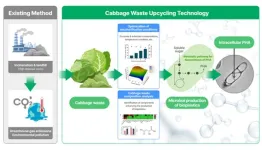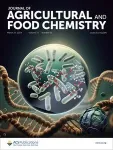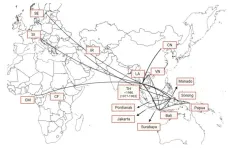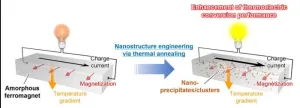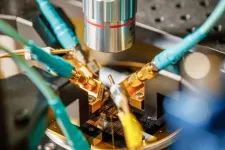(Press-News.org) As kimchi has been drawing attention as a global healthy food trend, cabbage is one of the representative vegetables used as a main ingredient for manufacturing kimchi overseas.
The annual global production of cabbage and other Brassica crops is reported to be 72 million tons, and more than 30% of them are estimated to be discarded during the manufacturing and distribution processes, causing environmental pollution as well as considerable waste disposal costs in the industry.
In connection with this problem, Hae Choon Chang, President of the World Institute of Kimchi (WiKim), a government-funded research institute under the Ministry of Science and ICT, announced on April 22 that the institute has developed a 'bio-refactoring-based upcycling technology' that can convert cabbage byproducts discarded as waste during the food manufacturing process into biodegradable plastics*.
※ Biodegradable plastics: Plastics that can be completely degraded by natural microbial activity under certain conditions
Bio-refactoring refers to a technology for redesigning microorganisms to give new functions other than their existing characteristics.
The research team led by Dr. Jung Eun Yang, a senior researcher of the Fermentation Regulation Technology Research Group at the WiKim, developed microbial strains for the production of biodegradable bioplastics by using bio-refactoring technology, and identified conditions for achieving a sugar conversion rate of up to 90.4% by optimizing the concentrations of enzymes and the substrate used in the saccharification process.
In particular, for the first time in the world, the research team found that malic acid, one of the bioactive materials in cabbage byproducts, can contribute to the productivity improvement of PHA* (Polyhydroxyalkanoate).
※ PHA (Polyhydroxyalkanoate): It is a bio-based biodegradable material obtained through microbial fermentation, and is characterized by biodegradability in natural environments.
The newly developed technology can be applied to various agricultural and food byproducts such as waste from cabbage and onions used for kimchi production, and is expected to reduce the waste disposal costs for byproducts from the kimchi manufacturing process, which are estimated to be 10 billion won per year.
“The results of this research are significant in terms of having secured an environmentally-friendly technology for converting agricultural and food waste into high value-added materials,” said Dr. Hae Woong Park, director of the Technology Innovation Research Division of the WiKim. He added, “We will continue to develop upcycling technology in the agricultural and food sectors so that the kimchi industry will contribute to the achievement of carbon neutrality.”
Meanwhile, the research team analyzed the components in cabbage byproducts, and systematically categorized various components helpful for microbial growth. Based on these research results, the team plans to develop the core technology to convert agricultural and food waste into various high-value-added materials.
This research has been published as the front cover article in the March 2024 issue of the ‘Journal of Agricultural and Food Chemistry (ACS Publications),’one of the top 10% international scholarly journals in the field of food science and technology.
※ Paper title: Valorization of Cabbage Waste as a Feedstock for Microbial Polyhydroxyalkanoate Production: Optimizing Hydrolysis Conditions and Polyhydroxyalkanoate Production
- Authors: (Corresponding author) Hae Woong Park, PhD (First author) Jung Eun Yang, PhD
END
Development of technology for producing bioplastics from agricultural and food byproducts by the World Institute of Kimchi
Identification of a material (malic acid) in cabbage byproducts contributing to the improvement of productivity of biodegradable plastics. Converting agricultural and food waste into high value-added materials: Achievement of carbon neutrality
2024-05-10
ELSE PRESS RELEASES FROM THIS DATE:
How the brain is flexible enough for a complex world (without being thrown into chaos)
2024-05-10
Every day our brains strive to optimize a trade-off: With lots of things happening around us even as we also harbor many internal drives and memories, somehow our thoughts must be flexible yet focused enough to guide everything we have to do. In a new paper in Neuron, a team of neuroscientists describes how the brain achieves the cognitive capacity to incorporate all the information that’s relevant without becoming overwhelmed by what’s not.
The authors argue that the flexibility arises from a key property observed in many neurons: “mixed selectivity.” While many neuroscientists used to think each cell had just one dedicated function, more recent evidence ...
Tracing HIV in Indonesia
2024-05-10
The HIV variant dominant in Indonesia was introduced from Thailand over multiple events. The Kobe University study traces where it came from and how it spread from there, offering insights of possible value to the development of treatments against the disease.
HIV is the virus causing AIDS, but one of the things that make it so difficult to treat is that there are many variants of it. Kobe University virologist KAMEOKA Masanori says, “The diversity is increasing every day and the prevalent virus strains differ from region to ...
Metabolism of autism reveals developmental origins
2024-05-10
Researchers at the University of California San Diego School of Medicine have shed new light on the changes in metabolism that occur between birth and the presentation of autism spectrum disorder (ASD) later in childhood. The researchers discovered that a small number of biochemical pathways are responsible for the majority of these changes, which could help inform new early detection and prevention strategies for autism.
“At birth, the physical appearance and behavior of a child who will develop autism over the next few years are indistinguishable from that of a neurotypical child. Indeed, in most cases the fate of the child with regard to autism is not ...
Comparative analysis of robot-assisted language learning systems and human tutors in English conversation lessons
2024-05-10
Advancements in large language models, robotics, and software such as text-to-speech, have made it possible to develop robots that can understand language, interact physically, and communicate verbally. These breakthroughs have opened up possibilities for robots to be used for educational purposes. However, this raises the question of whether robots are as good as human tutors. While robots offer certain benefits, they cannot replicate the nuanced interactions and personalized feedback human tutors provide.
To determine the suitability of using ...
Under 4-minute milers’ longevity shows that extreme exercise doesn’t seem to curb lifespan
2024-05-10
Extreme exercise doesn’t seem to shorten the lifespan as is widely believed, suggest the findings of a study on the longevity of the first 200 athletes to run a mile in under 4 minutes, and published online in the British Journal of Sports Medicine.
They outlive the general population by several years, shows the study, which marks the 70th anniversary of the seminal achievement of Roger Bannister, who was the first person to run a mile in under 4 minutes in May 1954.
While regular moderate exercise is considered a pillar of healthy ageing, ...
Journal retracts 6 further articles and corrects 2 others authored by former editor
2024-05-10
The British Journal of Sports Medicine has retracted six further articles authored by former editor, Dr Paul McCrory, and corrected another two, following an extensive investigation of his sole authored content in the journal.*
The retractions comprise four ‘warm up’ editorials and one book review due to plagiarism. A letter has also been retracted because of duplicate publication. And a research article and a review article have been corrected due to inappropriate reuse of content.
This latest tranche of retractions and corrections completes BMJ’s 2-year investigation ...
Running under a four-minute mile could be the key to a long and healthy life
2024-05-10
A new study released to mark the 70th anniversary of Sir Roger Bannister’s sub-four-minute mile record has revealed the first 200 runners to follow in his footsteps also share another remarkable trait.
The study from investigators in Australia and Canada found the 200 elite runners live on average almost five years longer than the general population.
Professor Mark Haykowsky, the Research Chair in Aging and Quality of Life in the Faculty of Nursing at the University of Alberta, says the findings published in the British Journal of Sports Medicine demonstrate the vital importance of aerobic fitness.
Professor Haykowsky says: “Breaking ...
Transforming common soft magnets into a next-generation thermoelectric conversion materials by 3 minutes heat treatment
2024-05-10
1. A research team from NIMS and Nagoya University has demonstrated that an iron-based amorphous alloy, widely used as a soft magnetic material in transformers and motors, can be transformed into a "transverse" thermoelectric conversion material that converts electric and thermal currents in orthogonal directions, with just a short period of heat treatment. This is the first example that highlights the importance of microstructure engineering in the development of transverse thermoelectric conversion materials, and provides new design guidelines for materials development to realize environmentally friendly power generation and thermal management technologies ...
Good vibrations: New tech may lead to smaller, more powerful wireless devices
2024-05-09
What if your earbuds could do everything your smartphone can do already, except better? What sounds a bit like science fiction may actually not be so far off. A new class of synthetic materials could herald the next revolution of wireless technologies, enabling devices to be smaller, require less signal strength and use less power.
The key to these advances lies in what experts call phononics, which is similar to photonics. Both take advantage of similar physical laws and offer new ways to advance technology. While photonics takes advantage of photons – or light – phononics does the same with phonons, which are the physical particles that transmit mechanical vibrations ...
Revolutionizing nurse work environment research
2024-05-09
PHILADELPHIA (May 9, 2024) – New research from Penn Nursing’s Center for Health Outcomes and Policy Research (CHOPR) – recently published online in the journal Research in Nursing & Health – has successfully validated a new, streamlined version of the Practice Environment Scale of the Nursing Work Index (PES-NWI), originally authored in 2002 by Eileen T. Lake, PhD, RN, FAAN, Professor of Nursing, the Edith Clemmer Steinbright Professor in Gerontology, and Associate Director of CHOPR, who is also lead author on this publication. This innovative tool, known as the PES-5, is designed to revolutionize how nurse work environments are measured across ...
LAST 30 PRESS RELEASES:
Numbers in our sights affect how we perceive space
SIMJ announces global collaborative book project in commemoration of its 75th anniversary
Air pollution exposure and birth weight
Obstructive sleep apnea risk and mental health conditions among older adults
How talking slows eye movements behind the wheel
The Ceramic Society of Japan’s Oxoate Ceramics Research Association launches new international book project
Heart-brain connection: international study reveals the role of the vagus nerve in keeping the heart young
Researchers identify Rb1 as a predictive biomarker for a new therapeutic strategy in some breast cancers
Survey reveals ethical gaps slowing AI adoption in pediatric surgery
Stimulant ADHD medications work differently than thought
AI overestimates how smart people are, according to HSE economists
HSE researchers create genome-wide map of quadruplexes
Scientists boost cell "powerhouses" to burn more calories
Automatic label checking: The missing step in making reliable medical AI
Low daily alcohol intake linked to 50% heightened mouth cancer risk in India
American Meteorological Society announces Rick Spinrad as 2026 President-Elect
Biomass-based carbon capture spotlighted in newly released global climate webinar recording
Illuminating invisible nano pollutants: advanced bioimaging tracks the full journey of emerging nanoscale contaminants in living systems
How does age affect recovery from spinal cord injury?
Novel AI tool offers prognosis for patients with head and neck cancer
Fathers’ microplastic exposure tied to their children’s metabolic problems
Research validates laboratory model for studying high-grade serous ovarian cancer
SIR 2026 delivers transformative breakthroughs in minimally invasive medicine to improve patient care
Stem Cell Reports most downloaded papers of 2025 highlight the breadth and impact of stem cell research
Oxford-led study estimates NHS spends around 3% of its primary and secondary care budget on the health impacts of heat and cold in England
A researcher’s long quest leads to a smart composite breakthrough
Urban wild bees act as “microbial sensors” of city health.
New study finds where you live affects recovery after a hip fracture
Forecasting the impact of fully automated vehicle adoption on US road traffic injuries
Alcohol-related hospitalizations from 2016 to 2022
[Press-News.org] Development of technology for producing bioplastics from agricultural and food byproducts by the World Institute of KimchiIdentification of a material (malic acid) in cabbage byproducts contributing to the improvement of productivity of biodegradable plastics. Converting agricultural and food waste into high value-added materials: Achievement of carbon neutrality
